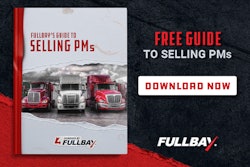If the challenges of finding and hiring drivers weren’t great enough, the process got a bit more complicated in late October. New rules took effect requiring prospective employers to obtain more information on driver applicants and former employers to not only provide that information but also to establish procedures for driver rebuttals, where needed, and to log the carriers to which safety performance information is required. The employment history check must cover three years, including accidents and drug and alcohol testing.
But despite some initial confusion and misunderstanding and a little extra work, the new rule doesn’t appear to be hampering motor carriers’ ability to hire drivers or burdening them with too much paperwork.
David Osiecki, vice president of safety, security and operations for the American Trucking Associations, says he hasn’t received much feedback from members one way or the other, although he cautions that a couple of months may not be enough time to make a meaningful assessment.
“It has been a lot smoother than we anticipated,” says Tim Shephard, vice president of safety and risk management for Roanoke, Va.-based Howell’s Motor Freight. “I have not seen any change other than a little more paperwork. In terms of response time or burdens – we haven’t seen it. It has been a non-event.”
“We haven’t had real difficulties,” says Ron Noel, director of safety for Cincinnati-based Besl Transfer Co. Noel says the slight increase in documentation requirements – documenting when the carrier makes and responds to requirements – hasn’t proved burdensome. And driver rebuttals have not been an issue yet for either Besl or Howell’s Motor Freight.
The eventual burden could grow if, as some carriers feared, drivers become more aggressive in filing rebuttals. And just as the burden is still a work-in-progress, so are the benefits. The rule requires carriers to obtain more information on drivers, but it doesn’t force them to take that additional information into account in hiring. And some believe that by allowing previous employers up to 30 days to respond to an employment history inquiry, FMCSA missed an opportunity to ensure a safer driving work force.
Time to prepare
Carriers that were paying attention had time to get their records and processes ready. The obligation to seek and respond to three-year employment checks kicked in Oct. 29 – six months after the rule took effect.
“We planned ahead,” Noel says. “We started back in June reviewing the rule, getting the documents, changing our application and so on.” But Noel didn’t see that same level of preparation in all carriers, so when the requirement to seek and provide a three-year check took effect, there was some confusion.
For example, some motor carriers apparently didn’t realize at first that they were required to provide employment history on a driver that still worked for them, Noel says. But the new rule explicitly defines previous employer to include current employer.
Others report confusion over the three-year accident register. Focusing on the Oct. 29 deadline for the expanded employment history checks, some carriers didn’t realize that the three-year requirement applied to accidents occurring after April 29, 2003.
In a broad sense, carriers had more than eight years’ notice of the change. The Federal Highway Administration proposed largely the same rule in 1996, but the final rule was delayed for various reasons, including concerns over carrier liability in the event information supplied by a carrier led to denied employment.
Congress addressed that concern in 1998, and many industry observers thought the rule would be issued promptly. In fact, DAC Services (now USIS) rolled out a new version of its employment history database in April 1998 in anticipation of the rule, says Kent Ferguson, product manager, proprietary databases for USIS. Carriers could store both DOT recordable and non-DOT recordable accidents and provide drug and alcohol history. But most carriers didn’t provide more information than they had to. “Maybe 60 to 65 percent had switched over to the new system by October 2004,” Ferguson says.
A faster turnaround?
ATA and others have been concerned that carriers would either have to wait up to 30 days for responses to employment history requests – hardly feasible given the realities of today’s driver recruiting challenge – or hire drivers conditionally subject to a clean record. That could mean putting a driver on the road for several weeks before discovering that the driver shouldn’t be on the road.
ATA asked FMCSA to reconsider and set the turnaround at five days. But FMCSA denied the petition in October, saying that due to the amount of information that a small carrier in particular would have to compile, a five-day window “is simply not practical. Many motor carriers are small businesses that cannot afford the administrative staff to process requests of this kind rapidly.” The agency pointed out that an owner-operator often is both a driver and an office manager and may be away from the office for several weeks.
FMCSA also noted that the rule represented an improvement over the previous requirements and that carriers can try to expedite the process themselves by working with previous employers or with private-sector providers. The agency invited the industry, however, to collect data showing the distribution or response times to previous employer requests and to suggest non-discriminatory methods of reducing those times.
ATA is likely to collect that data to see how significant the problem is, Osiecki says. But for many carriers, there’s no substitute for old-fashioned persistence. Besl Transfer’s Noel hasn’t seen a problem with turnaround, but company personnel don’t just sit back and wait for previous employers to respond at their leisure. “A 30-day delay could be detrimental to our recruiting effort. We are pretty pesky in trying to obtain that info.” Noel isn’t a fan of hiring on the condition that a complete background check follows. “We try to make sure that’s in place so that we don’t hire a mistake.”
For a copy of the final drivers safety performance rule, visit this site and search Docket No. 2277.
The market responds
Third-party providers help manage employment checks and responses
With the new driver history rule generating more paperwork, several third-party providers are offering tools to help.
J.J. Keller put considerable work into ensuring that its Driver Management Online system produces the correct forms and follows the correct procedures for handling driver rebuttals, logs requests for and dissemination of information and even prompts the user to double-check that the requesting party is a valid seeker of the data, says Randy Thome, corporate manager, data solutions for the company. Driver Management Online acts like an automated recordkeeping system, providing a single-source database on everything involving the driver, Thome says. So while the decision of when to provide the information remains with a human, the actual distribution of the information can be virtually instant.
USIS, long a leading third-party provider of employment verification data on truck drivers, recently introduced a solution for outsourcing the processing of requests for verification. The system, known as DAC Online, stores data on terminated and current drivers and now serves about a dozen large and medium-sized carriers, says Kent Ferguson, USIS product manager, proprietary databases. When a DAC Online customer receives a valid request for employment history, it directs the requestor to the website and provides a user name and password. The system also handles the Fair Credit Reporting Act requirements for notifying drivers and maintains the log that’s required under the regulations, Ferguson says.
A new entrant in the business is DOTJobHistory, an offering from TIES LLC. The distinction of DOTJobHistory is that drivers seeking jobs control the screening process, says Derek Hinton, chief executive officer of TIES LLC. Drivers can create profiles to ensure that their personal information, driving record and employment history information is correct – or at least that their version of events is included in the record. The information is verified independently, so it reflects the input of previous employers, Hinton says.
Carriers pay a fee of $9 or $15, depending on the scope of the check. The advantage for both the driver and the carrier is that it helps narrow the field faster to quality candidates, which is essential in today’s driver market, he says. “They can’t kiss 100 frogs to get 10 princes.”








